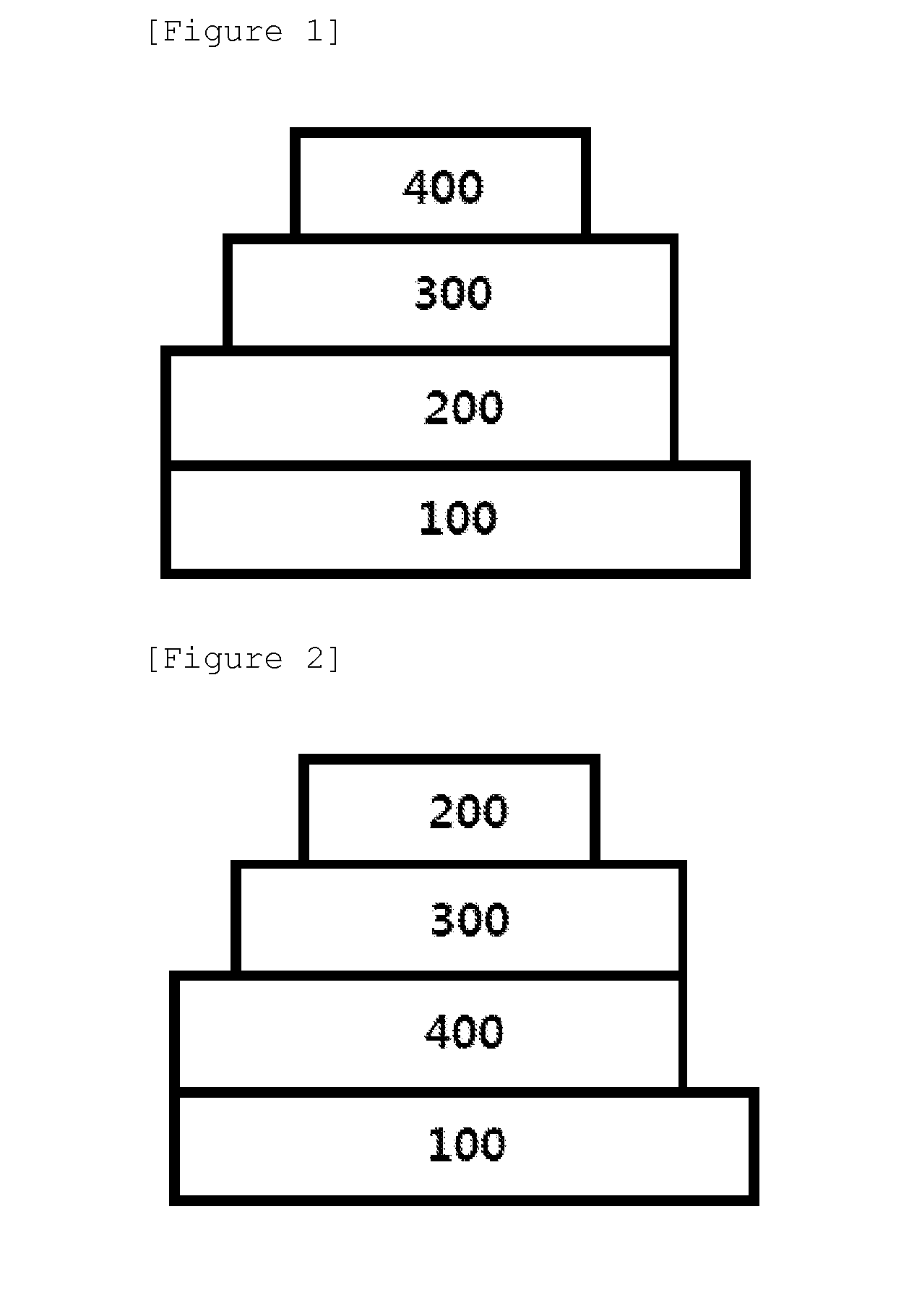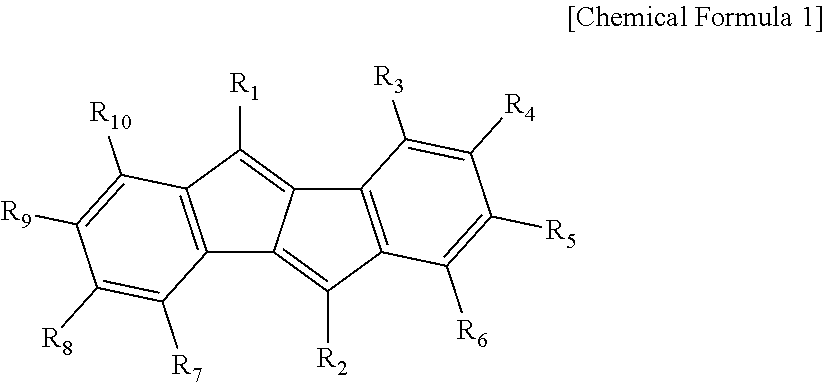Multicyclic aromatic compound and organic light emitting device using the same
a multi-cyclic aromatic compound and organic light emitting technology, applied in the direction of triarylamine dyes, pyrene dyes, anthracene dyes, etc., can solve the problems of unsatisfactory life span of organic light emitting devices, huge advantages in power efficiency, material change, etc., to achieve excellent light emitting efficiency, excellent life span properties of materials, and long life span of devices
- Summary
- Abstract
- Description
- Claims
- Application Information
AI Technical Summary
Benefits of technology
Problems solved by technology
Method used
Image
Examples
preparation example 1
Preparation of Compound 1
[0093]
Preparation of Compound 1-1
[0094]After 10 g (42.7 mmol) of dibenzopentalenedione and 22.5 g (108 mmol) of phosphorus pentachloride were placed in a vessel, the vessel was sealed and heated until a liquid formed, and then an excess acetic acid solution was added thereto and the result was stirred for 48 hours. After the reaction completed, the compound was filtered using water, and then the liquid was extracted using water and diethylether. The solution was vacuum distilled, and separated and purified using a column, resulting in 5.8 g (16.9 mmol) of Compound 1-1.
Preparation of Compound 1-2
[0095]5 g (14.6 mmol) of Compound 1-1 was dissolved in acetic acid, and then the mixture was heated under reflux for 4 hours. After the reaction completed, the result was extracted using diethylether and water, and recrystallized using ethyl acetate, resulting in 3 g (14.6 mmol) of Compound 1-2.
Preparation of Compound 1
[0096]A solution in which 6 g (29.4 mmol) of Comp...
preparation example 2
Preparation of Compound 5
[0097]
Preparation of Compound 5-1
[0098]To a solution in which 337 mg (1.77 mmol) of CuI and 744 mg (1.06 mmol) of Pd(PPh3)2Cl2 were dissolved in 150 ml of triethylamine, 3.2 g (31.8 mmol) of phenylacetylene and 10 g (35.3 mml) of 1-bromo-2-iodobenzene were added in consecutive order, and the mixture was stirred for 24 hours at room temperature. After the reaction completed, the result was washed with an ammonium chloride solution and then extracted using ethyl acetate. The solution was vacuum distilled, and separated and purified using a column, resulting in 9 g (35.0 mmol) of Compound 5-1.
Preparation of Compound 5
[0099]After 4.3 g (39 mmol) of hydroquinone, 12.67 g (38.9 mmol) of Cs2CO3, 5.9 g (38.9 mmol) of CsF, 0.12 g (0.59 mmol) of P(t-Bu)3 and 0.27 g (0.29 mmol) of Pd2(dba)3 were placed in a reaction vessel, a solution in which 5 g (19.45 mmol) of Compound 5-1 was dissolved in 150 ml of 1,4-dioxane was added thereto, and then the mixture was stirred for...
preparation example 3
Preparation of Compound 6
[0100]
Preparation of Compound 6-1
[0101]A solution in which 15 g (82.4 mmol) of 2-bromobenzonitrile and 16.2 g (98.9 mmol) of PhSOOH were dissolved in 100 ml of DMF was heated under reflux for 2 hours at 80° C. After the reaction completed, the result was extracted using ethyl acetate and water, and the solution obtained was vacuum distilled. The obtained solid was separated and purified using a column, and 18.0 g (70.0 mmol) of Compound 6-1 was obtained.
Preparation of Compound 6-2
[0102]15 g (58.3 mmol) of Compound 6-1, 60 ml of 1M DIBAL solution and 45 ml of dichloromethane was placed in a reaction vessel in consecutive order, and the mixture was stirred for 2 hours at −78° C. After that, an excess 1M ammonium chloride solution was added thereto and the result was stirred for additional 1 hour. After the reaction completed, the result was extracted using dichloromethane and a hydrochloric acid solution, and the solution obtained was vacuum distilled. The obt...
PUM
| Property | Measurement | Unit |
|---|---|---|
| temperature | aaaaa | aaaaa |
| temperature | aaaaa | aaaaa |
| Chemical Formula | aaaaa | aaaaa |
Abstract
Description
Claims
Application Information
 Login to View More
Login to View More - R&D
- Intellectual Property
- Life Sciences
- Materials
- Tech Scout
- Unparalleled Data Quality
- Higher Quality Content
- 60% Fewer Hallucinations
Browse by: Latest US Patents, China's latest patents, Technical Efficacy Thesaurus, Application Domain, Technology Topic, Popular Technical Reports.
© 2025 PatSnap. All rights reserved.Legal|Privacy policy|Modern Slavery Act Transparency Statement|Sitemap|About US| Contact US: help@patsnap.com



